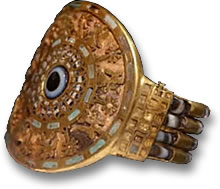The Golden Treasure of Nimrud
 |
| Gold Crown from the Treasure of Nimrud |
Nimrud was an ancient city of Assyria, located in the Tigris Valley of Northern Iraq. In the 1980s, an incredible archaeological discovery was made, which was comparable to that of King Tutankhamun's tomb in the 1930s. This was the royal tombs of Nimrud. However, not as many people have heard of the treasure of Nimrud as that of King Tut. This is probably because King Tut's treasure has toured the world since its discovery in the 1930s, while the golden treasure of Nimrud was only recently discovered and exhibited to the Iraqi public for a very short time before war broke out in Kuwait.
Assyria was one of the greatest empires of the Ancient Near East around the 14th century BC. Archaeological excavations of other tombs in the mid 1900s revealed ornaments and decorations, but the tombs of the Assyrian queens with their enormous amount of gold were not uncovered until around 1989. The golden artifacts are thought to be around 2700 years old.
 |
| Gold and Gemstone Inlay Bracelet |
The treasures were added to the collection at the Baghdad Museum. After the fall of Saddam Hussein, it was assumed that these beautiful artifacts may have been lost to looters. However, the Treasures of Nimrud were found in 2003 by a team funded by the National Geographic Society. The artifacts were hidden safely in a flooded vault of the Central Bank of Iraq. Not all of the items survived looters, but hundreds remain to be admired.
The treasure of just one of the royal tombs of Nimrud amounts to hundreds of gold jewelry items weighing over 26 kg, as well as precious gemstones and ornaments. It seems that a wide variety of sophisticated jewelry was made by the Assyrians, such as necklaces, armlets, rings, bracelets, crowns, anklets, amulets and decorations worn on clothing. Some of the artifacts have gold, carnelian and lapis lazuli inlay. There are also gold beads and a large amount of gold earrings. Some of the earrings have agate beads.
Some particularly striking gold necklaces from the Nimrud royal tombs have pendants. Some of the pendants are made from solid gold and others are inlaid with banded agate or brown and white agate eye pendants. Turquoise and carnelian were also used for necklaces. A pair of bracelets joined to sets of five rings are interesting items. These allowed the owner to wear ten rings and two bracelets all at once in the form of two single pieces of jewelry.
 |
| Gold Bracelet with Gemstones and Lions Heads |
The most breathtaking and famous pieces of jewelry worn by the Assyrian queens were crowns. The most exquisite gold crown of all was worn by the skeleton of a young woman. The top has a golden flower surrounded by thin gold leaves. Further down are figures with inlaid eyes and wings, followed by gold pomegranate beads and rosettes. Around the bottom edge there are intricate lapis lazuli grape pendants. Another beautifully detailed gold crown has a total of ninety-six rosettes in three rows (see, top image).
The golden treasure of the Assyrian queens of Nimrud may have been revealed after that of King Tut, but those who have seen it consider it to be just as wondrous as the well-known ancient Egyptian artifacts that caused Egyptomania and influenced art and jewelry at the time of their discovery. Even more amazing is that the collection survived untouched for so many years.
|
